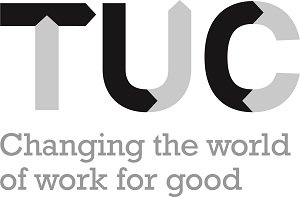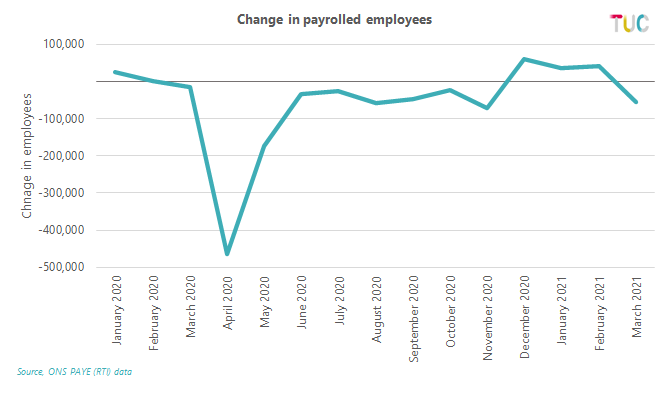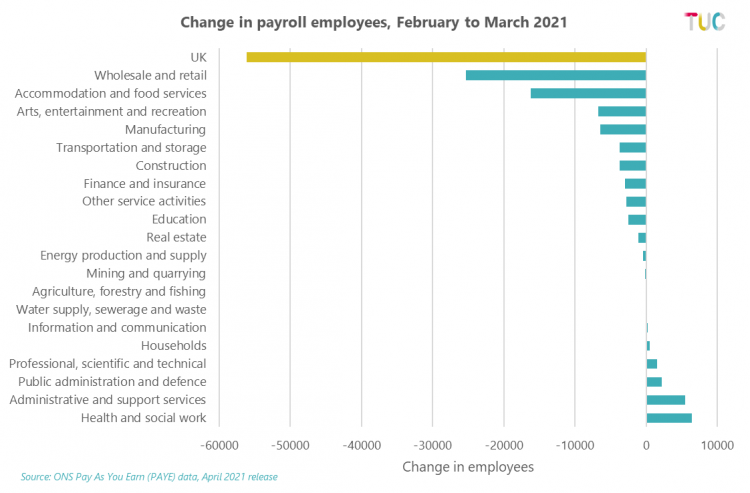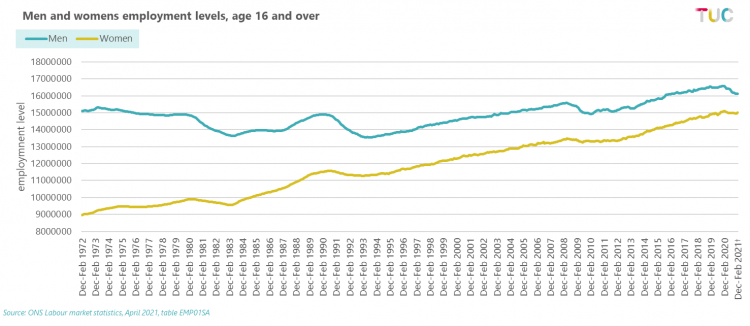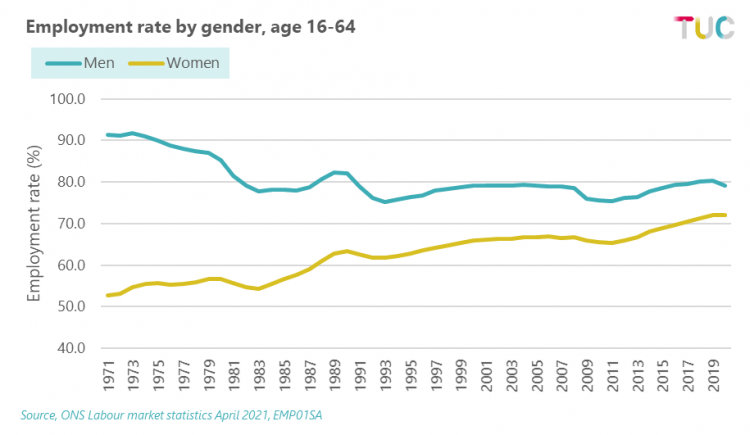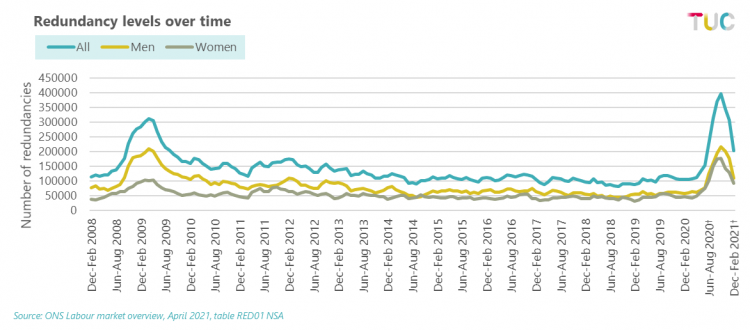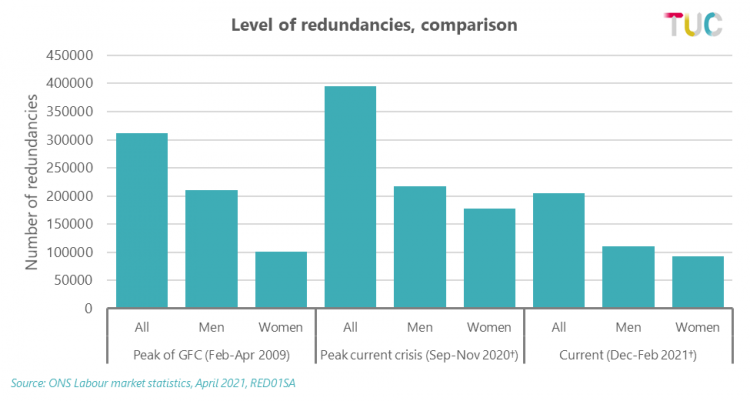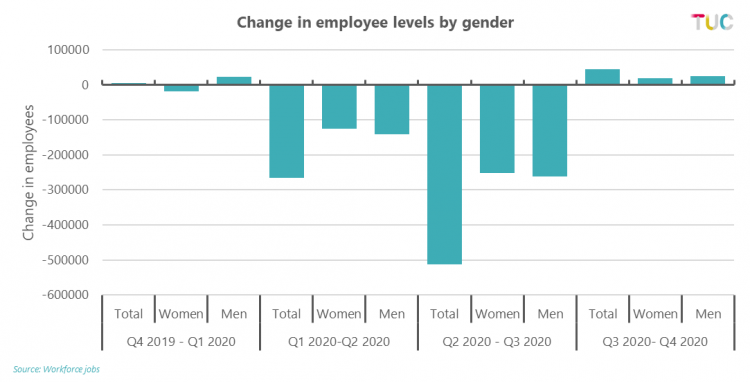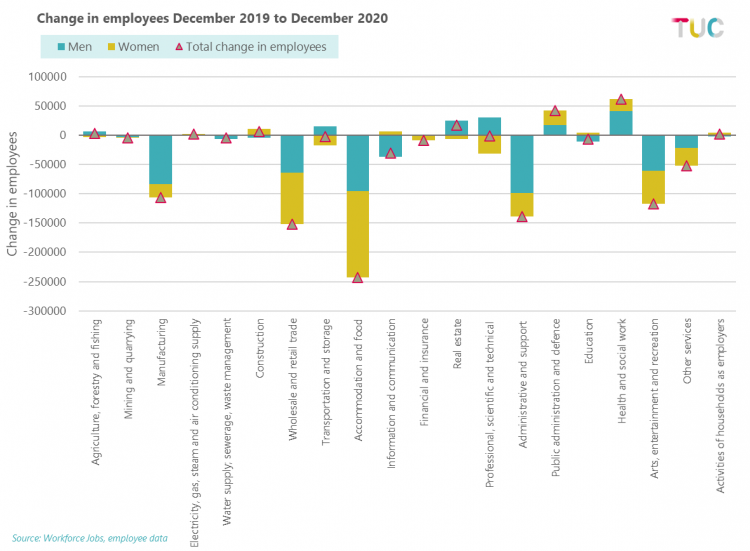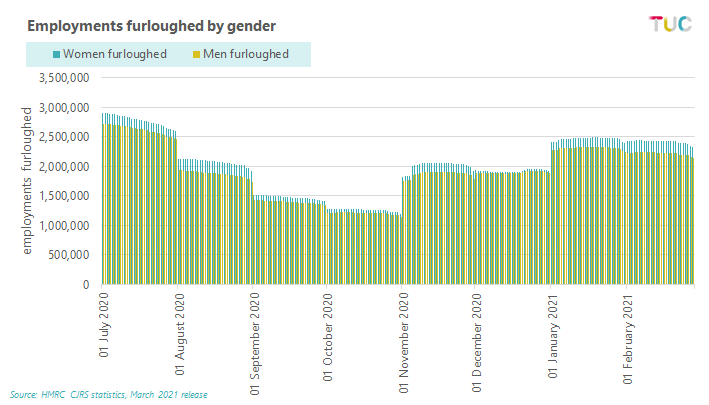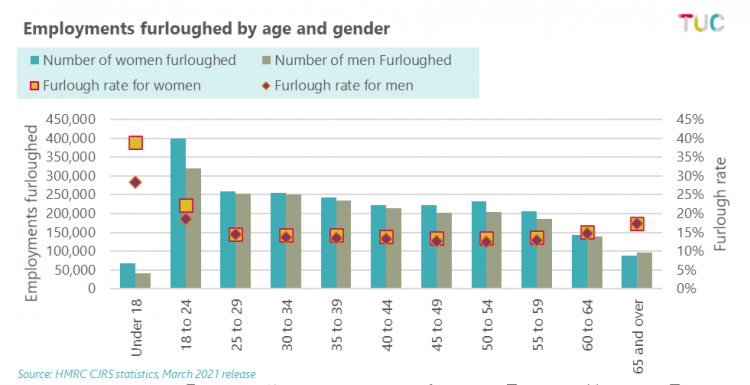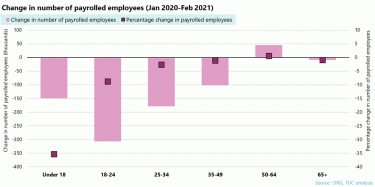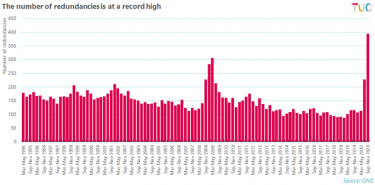Jobs and Recovery Monitor - Gender
Our analysis shows that while headline figures for women may look more stable, in reality, women have seen a much higher level of redundancy than in previous crises and are working in sectors that are particularly exposed to the economic impact of the pandemic, again something that goes against previous experience.
At the TUC we are calling for several policies that will help support all workers, and particularly women as we build back better, fairer and more equal from this crisis:
Industry
- Sector specific support for industries most affected by the pandemic, including having job support for as long as is needed. The TUC from the start of this crisis has been calling on the government to convene a national recovery council bringing together trade unions, government and employers to work together on how we build back better, fairer and more equal.
- Government investment in good green jobs including in the public sector and in caring professions.
- Support for the furlough scheme to remain in place for as long as the pandemic is affecting jobs.
Supporting and improving people’s incomes
- Government must raise the minimum wage for all workers to £10 per hour as soon as possible and end the public sector pay freeze.
- An increase in sick pay to at least the level of the Real Living Wage, for everyone in work, to ensure workers can afford to self-isolate if they need to.
- Universal credit must be completely reformed, but immediately the £20 uplift must be made permanent and the five week wait for first payments ended.
Workers’ rights
- Ban zero-hours contracts which particularly affect key workers in health and social care, and wholesale and retail, many of whom are women.
- Ten days' paid carers leave, from day one in a job, for all parents. Currently parents have no statutory right to paid leave to look after their children.
- A right to flexible work for all parents. Flexible working can take lots of different forms, including having predictable or set hours, working from home, job-sharing, compressed hours and term-time working.
Summary
In this edition of our jobs and recovery monitor we look at some of the headline labour market statistics before looking more closely at the impact of the pandemic from the perspective of gender.
Our analysis shows that women are seeing much higher levels of redundancies than in previous recessions, they continue to be more likely to be on furlough (particularly young women) and are overrepresented in industries that have been most severely hit by the pandemic.
Women have accounted for 60 per cent of the job losses in accommodation and food and 58 per cent of job losses in wholesale and retail, whereas in manufacturing men accounted for nearly 80 per cent of job losses. Overall, job losses have been fairly evenly spread – based on workforce jobs data for employees, women have accounted for 52 per cent of job losses and men 48 per cent. This contrasts to previous recessions where men saw a bigger impact generally.
Looking at headline numbers for all workers show slight changes in opposing directions with both the employment and unemployment rates down by 0.1 per cent. This could suggest some stabilisation in the labour market as furlough continues to support those workers and industries that remain restricted by the pandemic, and with the economy beginning to open up and a ‘bounce back’ assumed.
However, the picture is somewhat more complicated. Workforce jobs and payroll data sources continue to show a very mixed picture by industry and a much steeper decline in employment than the labour force survey data suggests.[1]
Previous monitors looking at the impact of the pandemic on Black and Minority Ethnic workers, young workers and regions, highlight how the pandemic is exacerbating existing inequalities. The TUC has also highlighted how the pay and employment gap for disabled workers has been widening.[2]
Headlines
Latest official labour market data shows the employment rate at 75.1%, for the period December to February, this is down 1.4 percentage points on the same period a year ago and down 0.1 percentage points on the previous quarter.
Unemployment fell slightly on the quarter, down 0.1 percentage points to 4.9%. However, this is still 0.9 percentage points higher than the same period a year ago.
The redundancy rate at 7.3 people per thousand is significantly higher than a year ago but has fallen since the previous quarter from 11 people per thousand and has almost halved from the record high of 14.2 people per thousand in the period September to November 2020.
Real time payroll data shows that after a small recovery in payrolled employees in February 2021, early estimates for March suggest a decline of 56,000.
[1]ONS state on all labour market statistics ‘Labour Force Survey (LFS) responses are weighted to official population projections. As the current projections are 2018-based they are based on demographic trends that pre-date the COVID-19 pandemic. We are analysing the population totals used in the weighting process and intend to make adjustments where appropriate. Rates published from the LFS remain robust; however, levels and changes in levels should be used with caution. This will particularly affect estimates for country of birth, nationality, ethnicity and disability.’ For discussion on why this might be happening see Office for National Statistics, Leaker, D, 29th January 2021, https://blog.ons.gov.uk/2021/01/29/painting-the-full-picture-what-our-statistics-tell-us-about-the-labour-market/ and O’Connor, M and Portes, J, 14th January 2021, https://www.escoe.ac.uk/estimating-the-uk-population-during-the-pandemic/
This has been driven largely by falls in the number of employees in wholesale and retail (a fall of 25,000) and accommodation and food (a fall of 16,000). Conversely only small gains in payrolled employees were seen across few industries and driven mostly by admin and support services (5400) and health and social care (6300).
The industry impact of the pandemic on jobs has important outcomes on the differing impact on women and men’s employment. We take a look at this in more detail below.
Looking at gender and the labour market
Levels of employment
According to latest Office for National Statistics data, the impact of this recession on men’s employment has been worse than for women.
December to February employment rates for men stand at 78.2 per cent, down 2.4 per cent on the year and 0.3 per cent on the previous quarter. For women, the employment rate stands at 72.1 per cent, 0.6 per cent down on the same period last year and 0.1 per cent up on the quarter. The unemployment rates for men and women stand at 5.2 and 4.9 per cent respectively, both up 1 per cent on the same period a year ago.
The charts below show employment levels and rates for men and women since the early 1970s, and highlight that historically, men’s employment has tended to fare worse during recession, so the headline stats would seem in line with previous experiences.
Redundancies
However, when we look at redundancy data, we can see that certainly in comparison to the global financial crisis, the redundancy impact for women and men has tracked much more closely so far
From a redundancy perspective, at the peak of this crisis to date, redundancies hit over 395,000 in September to November 2020, with 178,000 women being made redundant and 217,000 men. As the chart below shows this was higher than the peak of redundancies in the financial crisis (February to April 2009), but for women it was significantly higher (76 per cent higher) whereas for men it was just over 3 per cent higher. And redundancy data shows the current level of redundancies for women continues to remain close to the levels seen in the financial crisis (just over 93,000 versus over 100,000 in the financial crisis).
Workforce jobs
Looking at workforce jobs data gives us greater insight into why women are experiencing a much higher level of redundancy than in previous crises, how important looking at industry is and why there is a significant risk to women’s employment going forwards.
Looking at employees using workforce jobs data, shows that over the course of the Covid pandemic so far, falls in the number of jobs have hit both women and men, but with women employees showing a slightly higher incidence of job loss at 52 per cent. As the chart below shows, the timings of these job losses have been similar for both men and women
Throughout the pandemic, accommodation and food, wholesale and retail, arts, entertainment and recreation, administrative and support services and manufacturing have been most severely impacted in terms of job losses. Those five industries make up around 87 per cent of employee job losses between December 2019 and December 2020.
The chart below shows the gendered impact of job losses across industries between December 2019 and December 2020. Women have seen very steep job losses in a few industries and only negligible gains, whereas men seem to have a much more varied picture.
In accommodation and food, which has seen employee jobs fall by nearly 243,000 between December 2019 and December 2020, women accounted for 60 per cent of those who had lost their job. Similarly, in wholesale and retail women accounted for 58 per cent of the job losses (88,000 out of 152,000 job losses). Both these industries combined account for around a fifth of employment in the UK. Women also accounted for nearly 60 per cent of job losses in other services, which includes many customer facing services such as hairdressers and personal grooming and care services.
Conversely, men have seen a greater job loss in manufacturing, where they account for over 80 per cent of the job losses, and around 75 per cent of the workforce.
Furlough
Throughout the crisis women have been more likely to be furloughed than men, again reflecting that women are generally more likely to work in the industries most affected by the pandemic.
We can also see from the chart below that when new restrictions were introduced in November and January, women were more likely to be put (back) on furlough. Fewer women are in work than men, so the gap between men and women as a share of employment is also bigger.
Latest furlough data to the end of February shows that young people and young women in particular are more likely to be furloughed than any other age group. Furlough rates amongst women and men under 18 are 39 per cent and 28 per cent respectively. For 18–24-year-old women and men they are at 22 per cent and 19 per cent respectively. The average for women and men overall is 15 per cent for women and 14 per cent for men.
Conclusions and recommendations
Our analysis shows that it is essential to look at what is happening at industry level when looking at the impact of the pandemic on the labour market to understand how the continued fall out will affect different groups, particularly women. Our analysis shows that while headline figures for women may look more stable, in reality women have seen a much higher level of redundancy than in previous crises and are working in sectors that are particularly exposed to the economic impact of the pandemic, again something that goes against previous experience.
We also know from our research that headline labour market data doesn’t capture the full extent of women’s experiences during this crisis. Women are overrepresented in key worker roles on the frontline, and many working mothers have seen their unpaid care work and working hours explode during this pandemic, with 7 out of 10 being refused furlough by their employers when they requested it to support with caring responsibilities. The same research also found that a quarter of mums were worried they would lose their job either by being singled out for redundancy or by having their hours reduced.[1]
What needs to happen?
At the TUC we are calling for several policies that will help support all workers, and particularly women as we build back better, fairer and more equal from this crisis:
Industry
- Sector specific support for industries most affected by the pandemic, including having job support for as long as is needed. The TUC from the start of this crisis has been calling on the government to convene a national recovery council bringing together trade unions, government and employers to work together on how we build back better, fairer and more equal.
- Government investment in good green jobs including in the public sector and in caring professions.
- Support for the furlough scheme to remain in place for as long as the pandemic is affecting jobs.
Supporting and improving people’s incomes
- Government must raise the minimum wage for all workers to £10 per hour as soon as possible and end the public sector pay freeze.
- An increase in sick pay to at least the level of the Real Living Wage, for everyone in work, to ensure workers can afford to self-isolate if they need to.
- Universal credit must be completely reformed, but immediately the £20 uplift must be made permanent and the five week wait for first payments ended.
Workers’ rights
- Ban zero-hours contracts which particularly affect key workers in health and social care, and wholesale and retail, many of whom are women.
- Ten days' paid carers leave, from day one in a job, for all parents. Currently parents have no statutory right to paid leave to look after their children.
- A right to flexible work for all parents. Flexible working can take lots of different forms, including having predictable or set hours, working from home, job-sharing, compressed hours and term-time working.
Stay Updated
Want to hear about our latest news and blogs?
Sign up now to get it straight to your inbox
